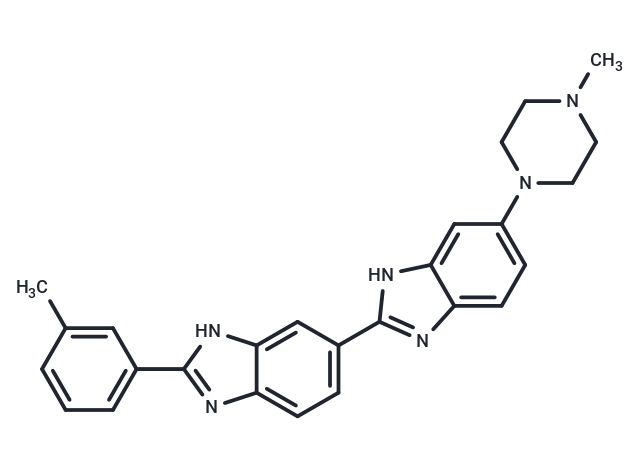Shopping Cart
Remove All Your shopping cart is currently empty
Your shopping cart is currently empty
Hoechst 33258 analog 2 is part of a family of blue fluorescent dyes used to stain DNA.

| Pack Size | Price | USA Warehouse | Global Warehouse | Quantity |
|---|---|---|---|---|
| 1 mg | $98 | - | In Stock | |
| 5 mg | $228 | - | In Stock | |
| 10 mg | $338 | - | In Stock | |
| 25 mg | $546 | - | In Stock | |
| 50 mg | $728 | - | In Stock | |
| 100 mg | $987 | - | In Stock | |
| 200 mg | $1,330 | - | In Stock |
| Description | Hoechst 33258 analog 2 is part of a family of blue fluorescent dyes used to stain DNA. |
| In vitro | The dyes Hoechst 33258 and Hoechst 33342 are the ones most commonly used and they have similar excitation/emission spectra. Both dyes are excited by ultraviolet light at around 350 nm, and both emit blue/cyan fluorescent light around an emission maximum at 461 nm. Unbound dye has its maximum fluorescence emission in the 510-540 nm range. Hoechst dyes are soluble in water and in organic solvents such as dimethylformamide or dimethyl sulfoxide. Concentrations can be achieved of up to 10 mg/mL. Aqueous solutions are stable at 2-6 °C for at least six months when protected from light. For long-term storage, the solutions are instead frozen at ≤-20 °C. Although the dyes can bind to all nucleic acids, AT-rich double-stranded DNA strands enhance fluorescence considerably. Hoechst dyes are cell-permeable and can bind to DNA in live or fixed cells. |
| Cell Research | I. Solution preparation 1. Stock solution preparation: Dissolve Hoechst 33258 analog 2 in DMSO or water to prepare a storage solution with a concentration of 1-10 mM. 2. Working solution preparation: Dilute to the appropriate concentration with PBS/DMEM/H2O before use. The common working concentration is 1-10 μM, but the specific concentration should be optimized according to experimental requirements. II. Cell staining 1. Cell culture: Culture cells in appropriate culture dishes to ensure that the cells reach an appropriate density (e.g., 70%-80% confluence). 2. Staining: Add the working concentration of Hoechst 33258 analog 2 to the cell culture medium. The common working concentration is 1-10 µM, but the specific concentration can be adjusted according to experimental needs. 3. Incubate cells at room temperature or 37°C for 10-30 minutes. The specific time can be adjusted according to experimental requirements. 4. Wash cells: After staining, wash cells with PBS (phosphate buffered saline) to remove unbound dye and prevent nonspecific staining. 5. Fluorescence detection: Hoechst 33258 analog 2 emits blue fluorescence under UV light (360 nm) excitation, with an emission wavelength of 460 nm. The dye binds specifically to DNA, and its fluorescence can be detected by a fluorescence microscope or flow cytometer equipped with appropriate filters. Notes: 1. Photosensitivity: Hoechst dye is light-sensitive, and long-term exposure to strong light may affect its fluorescence intensity. Therefore, it is recommended to handle in a low-light environment and avoid unnecessary light exposure during storage and operation. 3. Cytotoxicity: At high concentrations, Hoechst dye may be cytotoxic to cells. Therefore, the concentration needs to be optimized to reduce possible cell damage. |
| Molecular Weight | 422.52 |
| Formula | C26H26N6 |
| Cas No. | 23491-54-5 |
| Smiles | CN1CCN(CC1)c1ccc2nc([nH]c2c1)-c1ccc2nc([nH]c2c1)-c1cccc(C)c1 |
| Relative Density. | 1.276 g/cm3 (Predicted) |
| Storage | keep away from direct sunlight | Powder: -20°C for 3 years | In solvent: -80°C for 1 year | Shipping with blue ice/Shipping at ambient temperature. | |||||||||||||||||||||||||||||||||||
| Solubility Information | H2O: < 0.1 mg/mL (insoluble) DMSO: 60 mg/mL (142.01 mM), Sonication is recommended. | |||||||||||||||||||||||||||||||||||
Solution Preparation Table | ||||||||||||||||||||||||||||||||||||
DMSO
| ||||||||||||||||||||||||||||||||||||
| Size | Quantity | Unit Price | Amount | Operation |
|---|

Copyright © 2015-2025 TargetMol Chemicals Inc. All Rights Reserved.